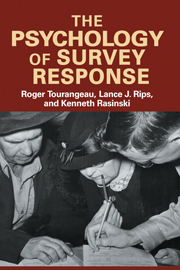Book contents
- Frontmatter
- Contents
- Preface
- 1 An Introduction and a Point of View
- 2 Respondents' Understanding of Survey Questions
- 3 The Role of Memory in Survey Responding
- 4 Answering Questions about Dates and Durations
- 5 Factual Judgments and Numerical Estimates
- 6 Attitude Questions
- 7 Attitude Judgments and Context Effects
- 8 Selecting a Response: Mapping Judgments to Survey Answers
- 9 Editing of Responses: Reporting about Sensitive Topics
- 10 Mode of Data Collection
- 11 Impact of Cognitive Models on Survey Measurement
- References
- Author Index
- Subject Index
2 - Respondents' Understanding of Survey Questions
Published online by Cambridge University Press: 05 June 2012
- Frontmatter
- Contents
- Preface
- 1 An Introduction and a Point of View
- 2 Respondents' Understanding of Survey Questions
- 3 The Role of Memory in Survey Responding
- 4 Answering Questions about Dates and Durations
- 5 Factual Judgments and Numerical Estimates
- 6 Attitude Questions
- 7 Attitude Judgments and Context Effects
- 8 Selecting a Response: Mapping Judgments to Survey Answers
- 9 Editing of Responses: Reporting about Sensitive Topics
- 10 Mode of Data Collection
- 11 Impact of Cognitive Models on Survey Measurement
- References
- Author Index
- Subject Index
Summary
Survey designers don't need to be reminded that the wording of the questions has an important impact on the results. Respondents can misinterpret even well-formulated questions, and when that happens, the question the respondent answers may not be the one the researcher intended to ask. Because of this obvious danger, the questions on national surveys are often subjected to empirical pretests. For example, the questionnaire designers may conduct cognitive interviews or focus groups in which they probe respondents' understanding of the questions and invite them to describe how they go about answering them (see Willis, DeMaio, & Harris-Kojetin, 1999, for a survey of these methods; we present a briefer discussion of them in Chapter 11). This practice is useful in bringing to light problems the designers may have overlooked.
This chapter looks at those aspects of survey questions that make them difficult for respondents to understand. These aspects are of many different sorts, ranging from features of grammar and word meaning to the broader situation in which the respondent and interviewer find themselves. Grammar can come into play either because the sentence is structurally ambiguous or because it includes complex clauses that respondents cannot parse. As an example of structural ambiguity, Item (1) asks respondents whether they agree or disagree with this statement:
(1) Given the world situation, the government protects too many documents by classifying them as SECRET and TOP SECRET. [GSS]
Information
- Type
- Chapter
- Information
- The Psychology of Survey Response , pp. 23 - 61Publisher: Cambridge University PressPrint publication year: 2000
Accessibility standard: Unknown
Why this information is here
This section outlines the accessibility features of this content - including support for screen readers, full keyboard navigation and high-contrast display options. This may not be relevant for you.Accessibility Information
- 3
- Cited by
